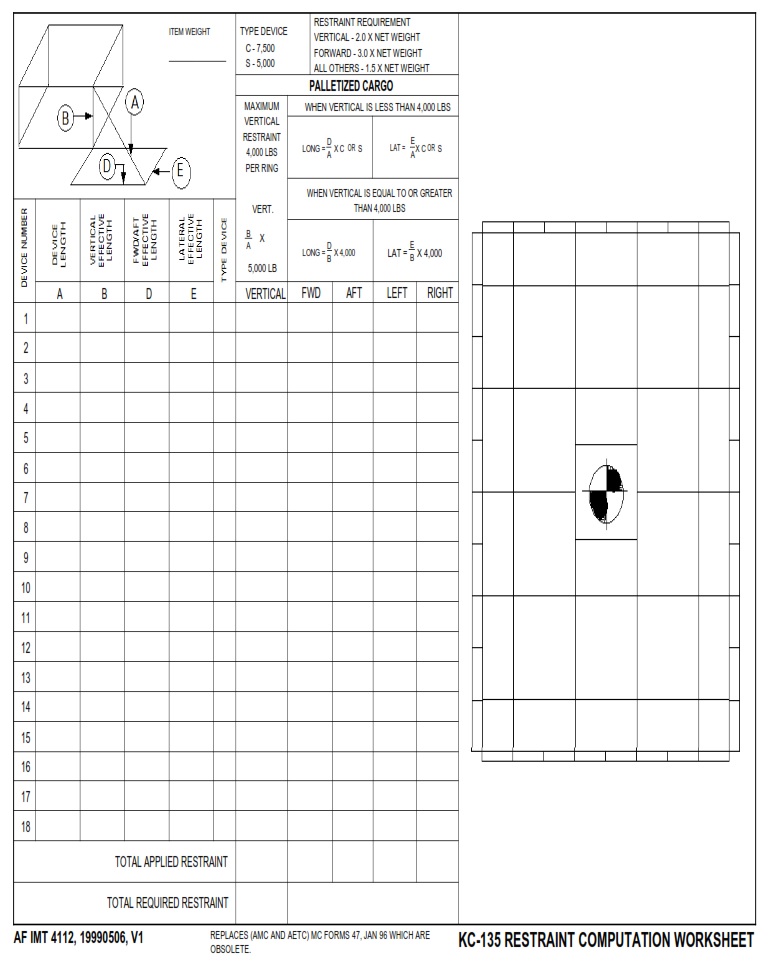AF-FORMS.COM – AF Form 4112 – KC-135 Retraint Computation Worksheet – Are you ready to delve into the world of aviation restraints and calculations? If so, buckle up (pun intended) because we’re about to explore the fascinating realm of the AF Form 4112 – KC-135 Restraint Computation Worksheet. This seemingly mundane document holds the key to ensuring the safety and security of personnel and cargo aboard one of the most iconic aerial refueling aircraft in history, the beloved KC-135 Stratotanker.
As you embark on this journey through the intricacies of restraint computation for the KC-135, prepare to be amazed by the meticulous attention to detail required in securing both human occupants and valuable equipment during flight. From calculating forces exerted during acceleration and deceleration to determining optimal attachment points for restraints, this form is a vital tool in maintaining a safe operational environment within this venerable airframe. Whether you’re an aviation enthusiast, a military buff, or simply curious about the inner workings of aircraft safety protocols, join us as we unravel the secrets hidden within AF Form 4112 – KC-135 Restraint Computation Worksheet.
Download AF Form 4112 – KC-135 Retraint Computation Worksheet
| Form Number | AF Form 4112 |
| Form Title | KC-135 Retraint Computation Worksheet |
| Edition Date | 5/6/1999 |
| File Size | 101 KB |
AF-Form-4112-KC-135-Retraint-Computation-Worksheet.pdf (26 downloads )
What is an AF Form 4112?
The AF Form 4112, also known as the KC-135 Retraint Computation Worksheet, is a critical document used in the United States Air Force for calculating and ensuring proper restraints on cargo transported by the KC-135 aircraft. This form plays a crucial role in maintaining safety and security during aerial transportation of various goods and equipment. It provides detailed instructions for computing the number and types of restraints required based on the weight, size, and characteristics of the cargo.
Furthermore, the AF Form 4112 serves as a vital tool for ensuring compliance with aviation regulations and guidelines, guaranteeing that all cargo is properly secured to prevent shifting or movement during flight. By meticulously detailing restraints needed for different types of cargo, this form helps maintain operational efficiency and minimizes risks inherent in aerial logistics. Ultimately, the AF Form 4112 underscores the meticulous planning and attention to detail essential to Air Force operations while prioritizing safety and precision in every aspect of transport logistics.
Where Can I Find an AF Form 4112?
If you’re looking for an AF Form 4112, you can find it on the official website of the Air Force or through your unit’s designated forms manager. The form is commonly used in conjunction with KC-135 restraints and serves as a crucial tool for computing the restraints necessary to secure cargo and personnel during flight. Understanding how to properly fill out and utilize this form is essential for ensuring the safety and security of all onboard personnel and equipment.
Additionally, seeking guidance from experienced aircrew members or supervisors can provide valuable insights into effectively using the AF Form 4112. It’s important to familiarize yourself with its purpose, layout, and calculations involved to ensure accuracy in restraint computations. By obtaining this form from reliable sources and gaining a thorough understanding of its use, you’ll be better equipped to contribute to safe and efficient operations within the Air Force.
AF Form 4112 – KC-135 Retraint Computation Worksheet
The AF Form 4112, also known as the KC-135 Retraint Computation Worksheet, plays a critical role in ensuring the safety and security of aircrew members during flight operations. This form is designed to calculate the necessary restraints required for securing cargo and personnel on board the KC-135 aircraft. It meticulously considers various factors such as weight distribution, acceleration forces, and potential turbulence to determine the most effective restraints needed for each specific mission. The level of detail and precision involved in completing this form underscores the Air Force’s unwavering commitment to maintaining the highest standards of safety and operational excellence.
Furthermore, the AF Form 4112 exemplifies the meticulous planning and attention to detail that is inherent in military aviation. By meticulously calculating restraint requirements based on mission-specific variables, this form embodies a proactive approach to mitigating risks and ensuring personnel safety. Additionally, it underlines the essential role of logistics and planning in every aspect of Air Force operations, emphasizing how even seemingly mundane tasks like filling out a worksheet can have far-reaching implications for mission success and crew welfare. Overall, the AF Form 4112 stands as a testament to the thoroughness and expertise that define military aviation operations.

